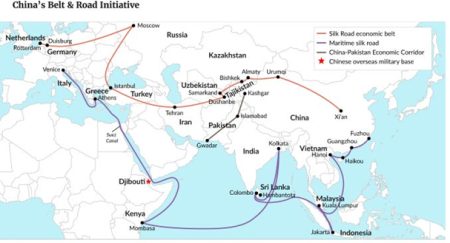2nd BRI Summit 2019 Is Underway In Beijing, China
The BRI or Belt and Road Initiative are also known as the One Belt One Road or Silk Road is a development strategy from China involving developing of infrastructure and investments in 152 countries and International Organisations.
In this article, we are going to study about Belt and Road Initiative. Its Importance for China and what if India joins this initiative. Also, the 2nd summit of BRI is going on so we will study some highlights of this summit as well
So Let’s start
What is Belt and Road Initiative?
- It is an initiative of Chinese foreign Policy initiated by Chinese President Xi Jinping in 2013.
- Its aim is to build a trade, investment, and infrastructure network connecting Asia with Europe and Africa along the ancient trade routes.
- There were two projects named as Silk Road Economic Belt and Maritime Silk Road was put forward but later on, they were merged and known as One Belt One Road. Later its name was changed to Belt and Road Initiative (BRI).
- It covers about 65% of the world population, 60% of the world GDP and over 70 countries in six economic corridors.
- The Communist Party of China has added this initiative into the Chinese constitution.
- Also, China is spending almost $1 trillion to revive and renew the overland and maritime trade links between China, Europe, West Asia, and East Africa through the construction of modern ports linked to high-speed road and rail corridors
Why India opposed BRI?
India has opposed BRI and did not attend the 2017 summit on the basis of lack sovereignty, transparency and unilateral decision making.
- The main reason is CPEC which is a flagship of BRI passes through Pakistan occupied Kashmir which is considered as the disputed territory by India.
- China will get access to the Indian Ocean with Gwadar Port which will provide a hindrance to freedom of navigation and trade energy security of India.
- Also, China’s port development projects in the Indian Ocean raises security concerns for India.
- Increasing Chinese presence in Nepal, Pakistan, Sri Lanka, and Myanmar has raised concerns for India.
What if India joins BRI?
- India will have direct access to Afghanistan and Central Asia.
- Ties between India and China will improve. China may cooperate on various global fronts.
- India will have economic benefits as their will be a boost in trade and business.
- Also, There are two major energy cooperation projects: The Iran-Pakistan-India gas pipeline and Turkmenistan-Afghanistan-Pakistan-India pipeline will not face many obstacles if India joins BRI.
Challenges in front of China
- The cost of development of projects is very high.
- Countries along the Belt and Road have different levels of development and at times poor governance conditions. This may hinder infrastructure development and the development of trade and investment.
- The political instability in the growing number of countries along BRI poses serious security concerns for BRI.
- Consequently, Pakistan pulled out from a deal to build the Diamer-Bhasha dam with China. The reason cited was strict deal conditions.
Highlights of 2nd Summit of BRI
- China has displayed a map with BRI routes.
- It shows entire Jammu and Kashmir and Arunachal Pradesh as part of India.
- Also, it shows India as a part of BRI even when India boycotted the summit for the second time.
- POK has been excluded from Pakistan’s map which can lead to serious implications on CPEC.
Furthermore, More than 65 countries- nearly every country in Asia (barring few like Bhutan, Japan), East and Central Europe have joined this initiative. Also, regional cooperation, political stability in countries along the road is important for BRI to succeed.
So this was it.
Stay tuned to DDE for more
Jai Hind
Also, Read






 Order Now on Amazon
Order Now on Amazon
